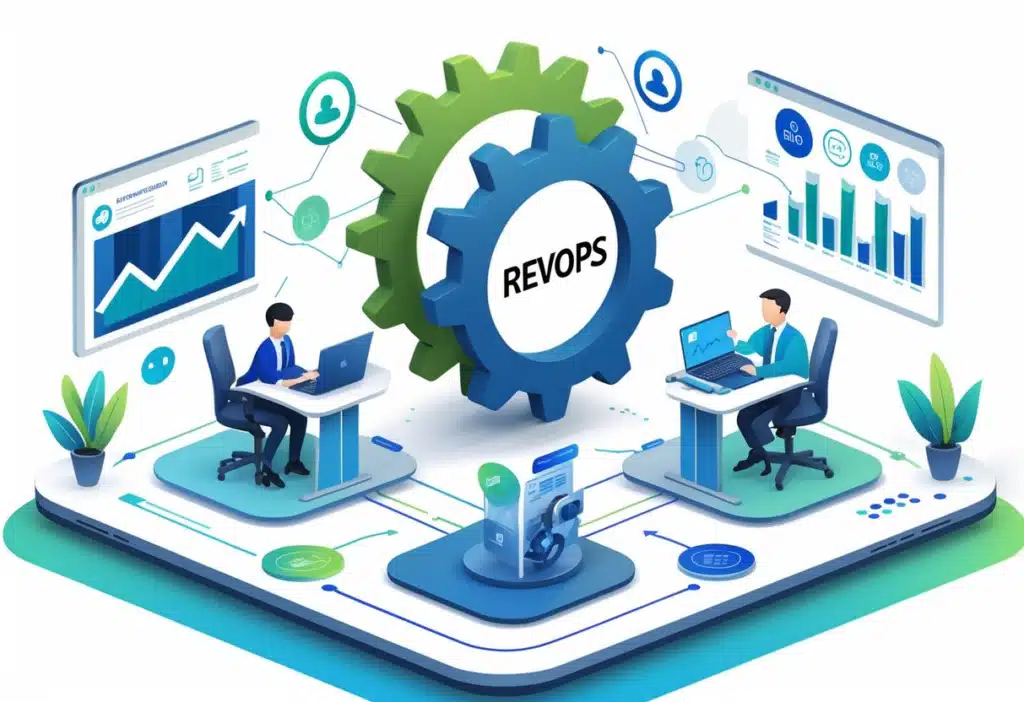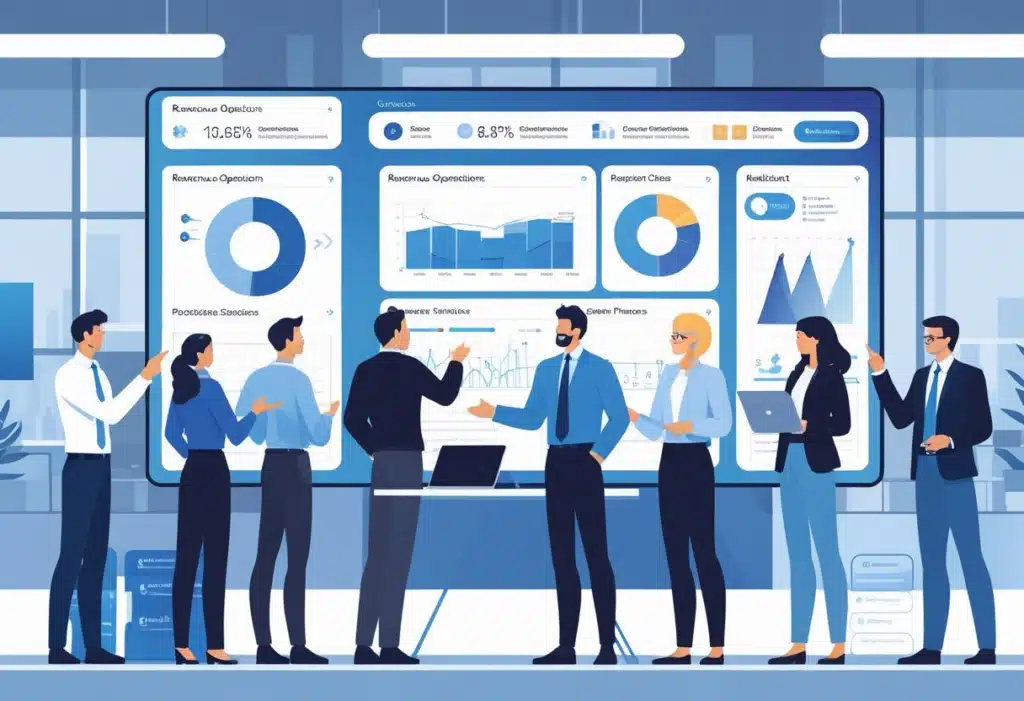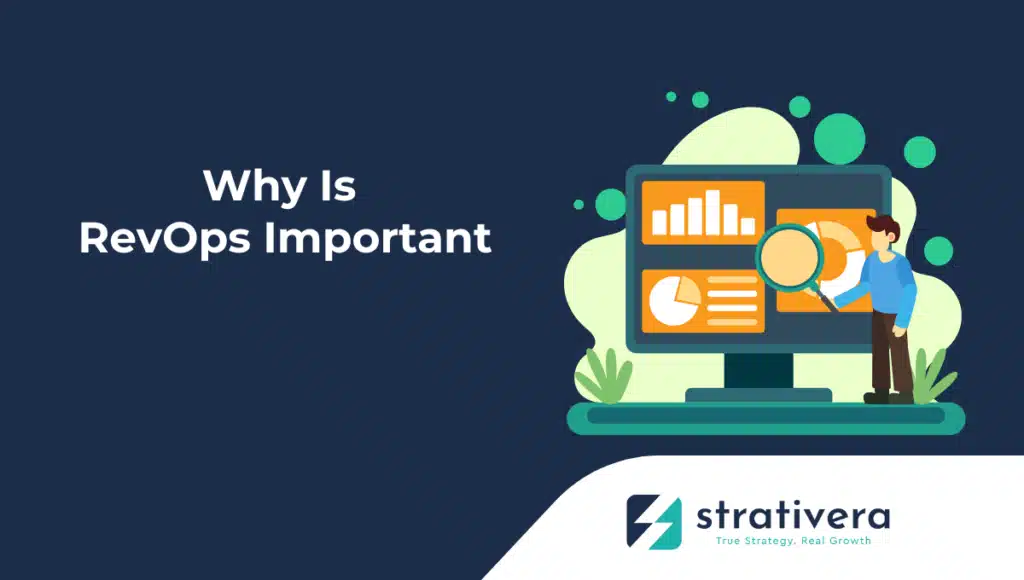Table of Contents
Most businesses deal with disconnected departments chasing different goals. This chaos drains revenue and slows growth.
RevOps tears down these silos by aligning sales, marketing, customer success, and finance teams around shared revenue goals. Teams work together, not against each other, which means smoother operations and more sustainable growth.

RevOps isn’t just about making departments talk to each other. It builds data-driven organizations that make smarter decisions at every step of the revenue cycle.
Companies that use RevOps usually see better lead conversion, higher customer retention, and stronger revenue growth. The difference is often pretty noticeable.
If you want to understand how RevOps really changes the game, you’ve got to look at its core components and how they work in practice. It’s about people, processes, technology, and using data to optimize performance—together, these drive results for businesses big and small.
What Is RevOps?

Revenue Operations (RevOps) is a strategic framework that brings all revenue-generating departments under one roof. This approach changes how organizations handle the entire customer lifecycle by breaking down silos and building coordinated revenue strategies.
Definition of Revenue Operations
Revenue Operations marks a big shift from the old way—where each department did its own thing—to a model where everyone works together. RevOps unites marketing, sales, customer success, and finance so they can actually drive business growth as a team.
The model keeps things simple: focus on people, processes, and technology. These three pieces come together to create a smooth customer experience, from first contact to renewal and beyond.
RevOps covers the whole revenue journey, from product development right through to collecting payment. Every revenue-related activity lines up with what the company wants to achieve.
Here’s what makes RevOps tick:
- Unified data management across departments
- Standardized processes and workflows
- Shared metrics and performance indicators
- Integrated technology stack
- Cross-functional collaboration protocols
The Role of RevOps in Modern Organizations
B2B and SaaS companies lean on RevOps to build predictable, scalable revenue. The model tackles the headaches that come from departments working in isolation.
RevOps clears up communication breakdowns that used to cause misaligned goals and missed chances. Businesses shift from operating in silos to acting as unified revenue teams.
RevOps gives leaders real-time visibility into crucial business metrics. They get a full view of customer behavior, sales performance, and revenue trends at every touchpoint.
What RevOps teams actually do:
- Data Integration: Bring customer info together from all platforms
- Process Optimization: Smooth out handoffs between teams
- Technology Management: Make sure systems talk to each other
- Performance Analysis: Track metrics across the whole revenue cycle
- Strategic Planning: Line up goals with revenue targets
Evolution from Traditional Operations to RevOps
In the past, organizations kept sales ops, marketing ops, and customer success as separate islands. Each one ran its own show, with its own tools and metrics.
Sales ops zeroed in on helping sales teams work better, but stayed focused on the middle of the funnel. Marketing and customer success did the same in their own corners.
This led to data silos, choppy customer experiences, and wasted effort. As companies grew, these problems only got worse.
RevOps came about when organizations realized they needed to pull all revenue functions together. By consolidating, they improved coordination and cut out inefficiencies.
Here’s how traditional ops and RevOps stack up:
| Traditional Operations | RevOps Model |
|---|---|
| Departmental silos | Cross-functional integration |
| Independent metrics | Unified KPIs |
| Separate technology stacks | Integrated systems |
| Limited data sharing | Centralized data management |
| Fragmented processes | Standardized workflows |
The move to RevOps shows just how much the B2B customer journey has changed—and how much companies need coordinated revenue strategies to compete now.
How RevOps Drives Revenue Growth

Revenue operations turns businesses from reactive to proactive by getting departments on the same page and tuning up processes. This approach leads to real, measurable growth and makes revenue far more predictable.
Accelerating Business Growth
RevOps gets rid of the silos that usually slow companies down. When marketing, sales, and customer success share processes and data, deals close faster and conversion rates climb.
Aligning sales, marketing, and customer success lets teams act on opportunities quickly because everyone’s looking at the same insights and numbers.
Automation is a big part of this. RevOps automates stuff like lead handoffs, quotes, and contracts. That way, teams can focus on the work that actually brings in money.
Some real benefits:
- Shorter sales cycles thanks to smoother processes
- Faster lead-to-customer conversions
- Better communication and handoffs between teams
- Scaling up without needing to hire a ton more people
Optimizing Revenue Generation
RevOps helps companies see the whole customer journey. Leaders can spot which activities bring the best return and which ones need fixing.
Every customer interaction gets tracked and analyzed, so teams can tweak strategies on the fly. This helps businesses find new revenue streams and cut out waste.
Sales teams finally get the full picture of every customer. Instead of awkward handoffs, reps know what prospects care about and what they’ve already talked about.
How RevOps boosts revenue:
| Area | Improvement |
|---|---|
| Lead Quality | Smarter scoring and qualification |
| Deal Size | More upselling and cross-selling |
| Win Rates | Sharper targeting and better sales methods |
| Customer Retention | Proactive success management and renewals |
Enabling Predictable Revenue Streams
RevOps builds predictable revenue by setting up consistent processes and reliable forecasting. Companies can actually trust their projections because they’re based on real data and current pipeline numbers.
Unified reporting wipes out the confusion from competing forecasts. Sales, marketing, and finance all pull from the same data, so predictions finally line up.
Predictable revenue comes from:
- Standardized sales processes that deliver steady results
- Reliable lead generation with tuned-up marketing
- Better customer retention through proactive management
- Accurate pipeline forecasting using smart CRM and analytics
Subscription-based companies really notice the benefits here. With everything in one system, they can model recurring revenue, churn, and expansion with surprising accuracy.
RevOps teams keep an eye on the numbers and adjust strategy as needed. This ongoing review helps maintain steady, predictable growth.
The Pillars of RevOps: People, Processes, and Technology

RevOps stands on three pillars that bring sales, marketing, and customer success into alignment. These basics help companies break silos, standardize the way they work, and roll out connected systems that support predictable growth.
Aligning and Empowering Teams
People are the core of any RevOps rollout. Companies need to rethink old department boundaries and encourage true teamwork between sales, marketing, and customer success.
Shared accountability matters when everyone’s aiming for the same revenue goals. Sales development reps often report to both sales and marketing, while customer success works hand-in-hand with sales on expansion deals.
RevOps sees people and teams as the backbone of company success. That means compensation and performance metrics need to reward working together—not just hitting solo targets.
New workflows mean new skills. Marketing folks pick up sales tactics, and sales folks learn about customer success. This cross-training smooths out handoffs and makes the customer journey feel seamless.
Building Efficient Processes
Standard processes help companies avoid the mess that comes from siloed teams. It’s about setting up unified lead scoring, consistent handoffs, and clear communication rules at every customer touchpoint.
Service level agreements set expectations. Marketing promises to deliver qualified leads on a schedule, and sales commits to following up and giving feedback on lead quality.
RevOps closes the gaps between planning and execution, making sure nothing falls through during key customer moments.
Good documentation keeps things running smoothly. Teams need easy-to-find playbooks for lead qualification, managing opportunities, and onboarding customers. Regular audits help spot and fix any bottlenecks.
Leveraging Technology for Scale
Integrating technology builds the backbone for RevOps. Organizations need unified stacks so data moves smoothly between marketing automation, CRM, and customer success platforms.
Real-time data sync wipes out manual entry and cuts down on errors. Marketing data updates lead records on its own. Sales activity can trigger workflows for customer success. Support interactions boost sales opportunity scoring.
The three pillars of people, process, and technology work together to speed up revenue growth with smarter, data-driven decisions. Technology makes this possible by offering unified dashboards and reporting.
Automation takes care of the routine stuff but leaves space for real human connections. Lead routing, follow-up, and data updates all happen automatically. Sales and customer success teams can focus on the conversations and relationships that actually move the needle.
RevOps and Cross-Team Collaboration

RevOps breaks down silos between departments and creates unified processes. Sales, marketing, and customer success teams all work toward shared revenue goals. This approach turns disconnected groups into a single revenue engine that delivers a steady customer experience.
Breaking Down Departmental Silos
Traditional business setups build walls between departments. Each team uses its own tools, metrics, and goals. Marketing hunts for leads, sales chases deals, and customer success tries to keep clients happy—often without knowing what happened before.
These silos waste resources and money. Poor alignment between marketing and sales can lead to revenue losses exceeding 10% according to research.
RevOps tears down those walls by setting shared metrics for all revenue teams. Instead of focusing on their own KPIs, everyone works toward the same goals that cover the whole customer journey.
The framework also brings in integrated tech stacks where CRM, marketing automation, and customer success tools all talk to each other. That way, everyone sees the same customer data and interactions.
Standardized processes keep workflows consistent from lead qualification to handoff. Teams follow documented steps, so prospects don’t get lost as they move through the funnel.
Strategic Alignment Across Go-To-Market Teams
RevOps unifies sales, marketing, and customer success under one operational system. This changes how teams coordinate and measure what actually works.
Marketing can finally see which campaigns bring in valuable customers—not just leads. Sales gets a full engagement history, showing exactly how prospects interacted with marketing before they entered the pipeline.
Customer success teams get the full story from first contact to contract signing. That context lets them deliver personalized onboarding and manage accounts proactively.
Unified revenue frameworks map out the whole customer journey together. Each team knows its role and how its actions affect the next step.
Cross-functional forecasting mixes data from all teams:
- Marketing’s lead volume and conversion rates
- Sales activity like pipeline speed and win rates
- Customer health metrics—churn risk and expansion chances
This approach gives more accurate revenue predictions than any single team could manage alone.
Enhancing Customer Experience
When teams coordinate, customers get a smoother experience from start to finish. Sharing information means customers don’t have to repeat themselves at every step.
RevOps makes sure transitions between teams are seamless. When prospects move from marketing to sales, the reps already know their interests and past interactions.
Customer success receives detailed onboarding packages—sales notes, pain points, and promises made. That way, they can deliver value right away instead of asking the same questions again.
Feedback loops collect customer insights and spread them to the right teams. Product feedback from customer success goes to marketing, who can tweak messaging. Sales objections help marketing create content that addresses those issues upfront.
Data integration gives everyone full customer visibility. Teams see real-time info about customer health, engagement, and expansion opportunities—without jumping between systems.
Data, Automation, and Performance Management
Revenue operations changes how companies handle data, system connections, and performance tracking. Organizations get better efficiency with automation and unified reporting that breaks down data silos.
Ensuring Data Integrity and Unified Reporting
Data integrity is the bedrock for effective RevOps. Organizations need centralized data hubs to clear up discrepancies across tools and platforms.
Core Data Management Requirements:
- One source of truth for all customer interactions
- Real-time data sync between systems
- Standardized data entry for every team
RevOps teams set up validation processes that flag inconsistent data. These systems stop duplicate records and keep customer info accurate as it moves between marketing, sales, and customer success.
Unified reporting clears up confusion. Sales and marketing both see the same engagement metrics for campaigns and customers.
Business intelligence platforms pull info from different touchpoints to build full customer profiles. Teams can finally make decisions based on the whole picture, not just their slice of it.
Data governance policies spell out who owns what and how to keep data clean. Teams follow the same rules for entry, updates, and quality control.
Driving Automation and Systems Integration
RevOps automation cuts manual work and boosts lead scoring, data management, and predictive analytics. Organizations set up automated workflows to handle repetitive tasks and speed up decisions.
Key Automation Areas:
- Lead scoring and routing based on behavior
- Email sequences and follow-ups
- Contract creation and approvals
- Report generation and sharing
Systems integration connects CRM, marketing automation, and customer success software. RevOps tech brings together CRMs, marketing, sales enablement, analytics, and customer success tools for unified operations.
Automated data processing wipes out entry mistakes. Systems update customer records automatically when someone interacts across channels.
Integration platforms let departments share info instantly. When marketing brings in a new lead, sales gets notified right away with all the details and engagement history.
Revenue performance management platforms track customers as they move through the buying journey. These systems spot bottlenecks and opportunities for improvement—no manual analysis needed.
Key Metrics and KPIs in RevOps
RevOps performance management fuels growth by tracking KPIs and keeping teams aligned. Organizations set up metrics that measure revenue effectiveness across all customer-facing teams.
Primary Revenue Metrics:
- Customer acquisition cost (CAC)
- Customer lifetime value (CLV)
- Monthly recurring revenue (MRR)
- Sales cycle length
- Lead conversion rates
Operational Efficiency Indicators:
- Pipeline velocity
- Deal win rates
- Customer churn rates
- Revenue per employee
Revenue performance management drills down into the numbers that really matter for growth. Teams track conversion rates at every stage to see where they can do better.
KPIs need to match across teams, or priorities start to clash. Marketing works on lead quality, sales focuses on conversion and deal size. It’s a balancing act, honestly.
Performance dashboards show real-time results. RevOps teams bring in analysts and specialists to dig into the data and optimize processes.
Predictive analytics helps organizations forecast revenue based on history and current pipeline. These insights let teams tweak marketing, sales strategies, and resource allocation before problems get big.
Technology Stack and Tools for RevOps Success
The right tech foundation can make or break RevOps. CRM platforms anchor everything, marketing automation tools handle smooth lead handoffs, and data orchestration connects all the moving parts.
Choosing and Integrating CRM Solutions
The CRM really is the heartbeat of RevOps. It pulls together all customer data for sales, marketing, and customer success—one place, one truth.
HubSpot is great for cross-team alignment and comes with built-in marketing automation. It’s easy to use and doesn’t need a lot of technical skill.
Salesforce gives you enterprise-level customization and robust API integrations. If you’ve got a complex sales process, Salesforce’s automation and reporting are tough to beat.
Key integration requirements:
- Two-way data sync between marketing and sales tools
- Real-time lead scoring and routing
- Custom field mapping for clean data
- API support for third-party apps
Good CRM integration kills data silos. Cycle times drop when qualification logic and task sequencing happen right inside the CRM.
The platform should support automated handoffs. When marketing-qualified leads show up, sales needs instant notifications and all the context.
Optimizing the Tech Stack
A solid RevOps tech stack starts with picking the right tools for your current needs, not what you might want three years from now. Companies often buy way more than they’ll ever use.
Revenue intelligence platforms help with forecasting:
- Gong uses AI to analyze sales calls and spot coaching opportunities
- Clari offers machine-learning forecasts based on CRM activity
- BoostUp gives predictive dashboards, especially for mid-market teams
Data orchestration tools keep you from exporting data manually and messing up fields. Zapier is good for basic automations, while Workato handles trickier, multi-app syncs.
Integration strategy really depends on your company’s stage. Early-stage teams can get by with HubSpot’s all-in-one setup. As you grow, you might add tools like ActiveCampaign for deeper marketing automation.
Common mistakes:
- Rolling out enterprise tools before you’re ready
- Letting one department pick cross-functional platforms
- Waiting on automation until things are already messy
Teams should go for tools with flexible APIs and good support docs. Saving money now on a weak tool can mean a costly re-platform later. It’s just not worth the headache.
Marketing Automation and Revenue Platforms
Marketing automation takes lead nurturing beyond just blasting out messages. Instead, it uses behavior-triggered sequences that actually respond to what visitors do—like checking a pricing page or signing up for a trial—and acts within minutes.
ActiveCampaign makes it pretty easy to get started and uses smart logic based on behavior. It plugs into most CRMs and lets you segment audiences in detail.
Marketo is the go-to for big companies that need deep personalization and more complex nurture flows. Larger teams often use its robust API to create custom integrations and handle advanced attribution.
For automation to really work, you need your CRM to talk to your marketing tools in both directions. When someone interacts with key content or lands on a high-intent page, sales gets notified right away—no waiting around.
Essential automation workflows include:
- Scoring leads based on their engagement and who they are
- Nurture sequences that kick off when certain behaviors happen
- Instant sales alerts for high-intent actions
- Re-engagement for leads that have gone cold
Revenue platforms need to tie marketing activities to real pipeline results. Attribution tracking helps teams figure out which campaigns actually bring in solid opportunities—not just vanity numbers.
Most modern platforms bake in AI insights to predict who’s likely to convert. Sales can then focus on the folks with the strongest engagement and clear buying signals.
Measuring and Improving ROI with RevOps
Revenue Operations turns scattered data into something you can actually measure. By syncing up sales, marketing, and customer success around shared goals, companies can track the impact of RevOps with real KPIs and spot friction in the pipeline.
ROI Impact of RevOps Initiatives
Measuring RevOps ROI starts with clear baselines—think average deal size, sales cycle length, and customer acquisition cost before you roll out changes.
The most important metrics for tracking RevOps impact:
- Sales Cycle Length – how fast deals move from first touch to close
- Customer Acquisition Cost (CAC) – efficiency in generating and converting leads
- Net Revenue Retention (NRR) – how well you keep and grow existing customers
- Lead-to-Customer Conversion Rate – how well the funnel is working
Most organizations notice real improvements in 3–6 months after starting RevOps. Solid RevOps work usually cuts CAC by 10–15% and boosts win rates by improving lead quality and sales alignment.
To figure out RevOps ROI, companies divide the revenue lift by the total investment—covering tech, people, and rollout costs over the time period.
Forecasting and Pipeline Visibility
RevOps pulls together marketing, sales, and customer success data into dashboards everyone can use. The result? Teams see real-time deal progress and can actually predict revenue.
Pipeline velocity metrics show where deals get stuck. Teams track how fast opportunities move through each sales stage.
Key forecasting improvements include:
| Metric | Before RevOps | After RevOps |
|---|---|---|
| Forecast Accuracy | 60-70% | 85-95% |
| Pipeline Visibility | Limited | Real-time |
| Deal Stage Clarity | Subjective | Data-driven |
Advanced lead scoring now goes beyond just clicks—it considers company fit, industry trends, and past deal values. Sales can then focus on the highest-value prospects and improve conversions.
Revenue intelligence works best when your CRM is well-integrated and you’ve got clear lifecycle stages plus multi-touch attribution. That’s how teams figure out which marketing channels and sales actions really drive results.
Addressing Friction Points and Challenges
One big headache in RevOps is linking operational changes to real financial outcomes. Many companies wrestle with conflicting KPIs and messy data definitions across systems.
Common friction points:
- Data silos between marketing and CRM platforms
- Different definitions of what counts as a qualified lead
- Manual reporting that slows down decisions
- Attribution gaps in multi-touch journeys
RevOps teams tackle these issues by standardizing how data gets collected and rolling out automated workflows. Integrating tools like HubSpot and Salesforce helps cut down on manual errors.
Clear handoff protocols between marketing and sales teams also help smooth things out. Agreeing on lead scoring rules and response times for qualified leads makes a real difference.
Tools like Gong, Clari, and Dreamdata dig into deal patterns and revenue attribution across touchpoints. These platforms help teams spot what’s working and where they can boost ROI.
FAQs – Why is RevOps Important
RevOps teams drive revenue growth by making decisions based on data and optimizing processes. Their specialized skills and certifications can lead to big operational improvements and, let’s be honest, a healthier bottom line.
How does RevOps contribute to revenue growth management?
RevOps boosts revenue growth by pulling together data from marketing, sales, and customer success. That way, teams break down silos and actually get a full picture of the customer.
The framework gives you more predictable revenue through better forecasting. Teams can spot where deals stall and fix conversion issues in the pipeline.
Revenue operations teams track key numbers like CAC, annual recurring revenue, and customer lifetime value. These metrics give teams a clear view of how revenue is performing and where growth is possible.
When departments work together, customers get consistent messaging and smoother handoffs. This makes the buying journey less bumpy and helps close more deals.
What are the main responsibilities of a RevOps team in a SaaS company?
RevOps teams in SaaS focus a lot on subscription metrics and keeping revenue coming in. They keep an eye on churn, renewals, and upselling to current customers.
The team oversees the whole product-to-cash journey—from lead generation to payment collection. That includes running CRMs, marketing automation, and billing systems.
Data integration is a core job for SaaS RevOps folks. They make sure customer info flows smoothly between marketing, sales, and customer success.
RevOps pros set up automated workflows for lead scoring, managing opportunities, and onboarding new customers. These automations save time and boost efficiency.
They also handle territory planning and quota setting. By analyzing market data and past results, they set realistic revenue targets for the team.
In what ways does RevOps impact the overall efficiency of sales and marketing teams?
RevOps breaks down the walls between sales and marketing. This means leads get handed off more smoothly and prospects don’t get lost in the shuffle.
Marketing can finally see which campaigns actually drive revenue, not just clicks. Sales gets better-qualified leads with a full history of interactions and behaviors.
When both teams use the same tech stack, everyone has access to real-time data. Sales reps can see everything a prospect has done before reaching out.
Standardizing processes across teams ensures customers get a consistent experience. Everyone follows the same playbook for qualifying leads, managing deals, and communicating.
RevOps teams put automated lead routing and scoring in place. This helps prospects reach the right person fast, based on what they’ve done and what they need.
Can RevOps certifications enhance the effectiveness of business operations?
Professional RevOps certifications give teams a proven framework to follow. Certified folks know how to tackle data integration, process improvements, and cross-team alignment.
Certification covers the essentials—CRM management, marketing automation, and revenue analytics. These skills help teams get the most out of their tech and processes.
Companies with certified RevOps pros usually roll out new initiatives faster. Certified team members know where the pitfalls are and how to avoid them.
Training programs focus on making decisions based on data and understanding metrics. That helps teams spot insights and act on revenue trends.
What roles do RevOps Engineers play within the revenue operations framework?
RevOps Engineers handle the technical backbone of revenue operations. They design and maintain integrations between CRM, marketing, and finance tools.
These engineers build custom dashboards and set up automations. Their work keeps data flowing in real time and cuts out manual entry headaches.
System optimization is a big part of the job. They look for bottlenecks and fix them to speed up data processing and make everything more accurate.
RevOps Engineers work with IT to keep data secure and compliant. They set up access controls and audit trails to protect sensitive info.
They also manage APIs and third-party integrations. Engineers test out new tools and bring in tech that strengthens the RevOps stack.
How does adopting a RevOps approach affect a company’s bottom line?
Companies implementing RevOps see reduced customer acquisition costs thanks to more efficient marketing and better conversion rates.
Better lead qualification and nurturing? That means teams bring in more solid opportunities instead of chasing dead ends.
Revenue predictability jumps up when you roll out RevOps. Organizations actually get a real look at their pipeline health and can finally forecast revenue with some confidence.
Process automation reduces operational costs by cutting out manual tasks. You don’t need as many people handling the same old busywork.
Teams can manage way more prospects and customers without scrambling to hire extra hands every time things get busy.
Customer retention gets a boost because everyone coordinates on post-sale experiences and stays ahead of issues. That higher retention? It feeds directly into recurring revenue and lifetime value, which is what you want anyway.
Deal velocity speeds up when sales teams have all the data they need and don’t get stuck in endless approval loops.
Faster deal cycles mean you hit those quarterly numbers more often—and who doesn’t want to see annual growth rates climb?

